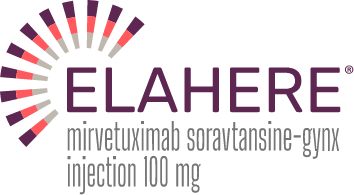-
ELAHERE can cause severe ocular toxicities, including visual impairment,
keratopathy, dry eye, photophobia, eye pain, and uveitis.
-
Conduct an ophthalmic exam including visual acuity and slit lamp exam
prior to initiation of ELAHERE, every other cycle for the first 8 cycles,
and as clinically indicated.
-
Administer prophylactic artificial tears and ophthalmic topical steroids.
-
Withhold ELAHERE for ocular toxicities until improvement and resume at the
same or reduced dose.
- Discontinue ELAHERE for Grade 4 ocular toxicities.
ELAHERE can cause severe ocular adverse reactions, including visual
impairment, keratopathy (corneal disorders), dry eye, photophobia, eye pain,
and uveitis.
Ocular adverse reactions occurred in 59% of patients with ovarian cancer
treated with ELAHERE. Eleven percent (11%) of patients experienced Grade 3
ocular adverse reactions, including blurred vision, keratopathy (corneal
disorders), dry eye, cataract, photophobia, and eye pain; two patients (0.3%)
experienced Grade 4 events (keratopathy and cataract). The most common
(≥5%) ocular adverse reactions were blurred vision (48%), keratopathy
(36%), dry eye (27%), cataract (16%), photophobia (14%), and eye pain (10%).
The median time to onset for first ocular adverse reaction was 5.1 weeks
(range: 0.1 to 68.6). Of the patients who experienced ocular events, 53% had
complete resolution; 38% had partial improvement (defined as a decrease in
severity by one or more grades from the worst grade at last follow up). Ocular
adverse reactions led to permanent discontinuation of ELAHERE in 1% of
patients.
Premedication and use of lubricating and ophthalmic topical steroid eye drops
during treatment with ELAHERE are recommended. Advise patients to avoid use of
contact lenses during treatment with ELAHERE unless directed by a healthcare
provider.
Refer patients to an eye care professional for an ophthalmic exam including
visual acuity and slit lamp exam prior to treatment initiation, every other
cycle for the first 8 cycles, and as clinically indicated. Promptly refer
patients to an eye care professional for any new or worsening ocular signs and
symptoms.
Monitor for ocular toxicity and withhold, reduce, or permanently discontinue
ELAHERE based on severity and persistence of ocular adverse reactions.
Severe, life-threatening, or fatal interstitial lung disease (ILD), including
pneumonitis, can occur in patients treated with ELAHERE.
Pneumonitis occurred in 10% of patients treated with ELAHERE, including 1%
with Grade 3 events and 1 patient (0.1%) with a Grade 4 event. One patient
(0.1%) died due to respiratory failure in the setting of pneumonitis and lung
metastases. One patient (0.1%) died due to respiratory failure of unknown
etiology. Pneumonitis led to permanent discontinuation of ELAHERE in 3% of
patients.
Monitor patients for pulmonary signs and symptoms of pneumonitis, which may
include hypoxia, cough, dyspnea, or interstitial infiltrates on radiologic
exams. Infectious, neoplastic, and other causes for such symptoms should be
excluded through appropriate investigations. Withhold ELAHERE for patients who
develop persistent or recurrent Grade 2 pneumonitis until symptoms resolve to
≤ Grade 1 and consider dose reduction. Permanently discontinue ELAHERE in all
patients with Grade 3 or 4 pneumonitis. Patients who are asymptomatic may
continue dosing of ELAHERE with close monitoring.
Peripheral neuropathy occurred in 36% of patients with ovarian cancer treated
with ELAHERE across clinical trials; 3% of patients experienced Grade 3
peripheral neuropathy. Peripheral neuropathy adverse reactions included
peripheral neuropathy (20%), peripheral sensory neuropathy (9%), paraesthesia
(6%), neurotoxicity (3%), hypoaesthesia (1%), peripheral motor neuropathy
(0.9%), polyneuropathy (0.3%), and peripheral sensorimotor neuropathy (0.1%).
Monitor patients for signs and symptoms of neuropathy, such as paresthesia,
tingling or a burning sensation, neuropathic pain, muscle weakness, or
dysesthesia. For patients experiencing new or worsening PN, withhold dosage,
dose reduce, or permanently discontinue ELAHERE based on the severity of PN.
Based on its mechanism of action, ELAHERE can cause embryo-fetal harm when
administered to a pregnant woman because it contains a genotoxic compound
(DM4) and affects actively dividing cells.
Advise pregnant women of the potential risk to a fetus. Advise females of
reproductive potential to use effective contraception during treatment with
ELAHERE and for 7 months after the last dose.
The most common (≥20 %) adverse reactions, including lab abnormalities, were
increased aspartate aminotransferase, fatigue, increased alanine
aminotransferase, blurred vision, nausea, increased alkaline phosphatase,
diarrhea, abdominal pain, keratopathy, peripheral neuropathy, musculoskeletal
pain, decreased lymphocytes, decreased platelets, decreased magnesium,
decreased hemoglobin, dry eye, constipation, decreased leukocytes, vomiting,
decreased albumin, decreased appetite, and decreased neutrophils.
DM4 is a CYP3A4 substrate. Closely monitor patients for adverse reactions with
ELAHERE when used concomitantly with strong CYP3A4 inhibitors.
Advise women not to breastfeed during treatment with ELAHERE and for 1 month
after the last dose.
Avoid use of ELAHERE in patients with moderate or severe hepatic impairment
(total bilirubin >1.5 ULN).
ELAHERE is indicated for the treatment of adult patients with folate
receptor-alpha (FRα) positive, platinum-resistant epithelial ovarian,
fallopian tube, or primary peritoneal cancer, who have received one to three
prior systemic treatment regimens. Select patients for therapy based on an
FDA-approved test.
Please see
Full Prescribing Information,
including Boxed WARNING.


